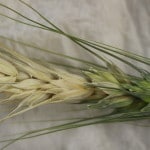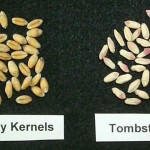Most of the wheat in Tennessee is in the milking/dough growth stage (early kernel growth stages – Feekes 11.1 to 11.2) and the window to apply fungicides has passed. Fungicides applied to manage Fusarium Head Blight (Scab) have a Pre-Harvest Interval (PHI) of 30 days, which roughly equates to 6 days after flowering as the latest possible application. Symptoms of Scab may be visible in fields 15 to 20 days after flowering, before wheat starts to mature and turn golden. With 10% or more of spikelets or heads showing symptoms DON levels (Deoxynivalenol – a mycotoxin produced by Fusarium fungi) may be problematic.
Fusarium head blight (Scab) pathogens can survive on host residues, which typically include wheat, barley, and corn; and can persist there for several years. Losses due to Scab include reduction in yield due to sterile florets and poor seed filling. Additionally, disease wheat may contain mycotoxins, usually deoxynivalenol (DON or vomitoxin), which can remain stable for years in stored grain. The consumption of mycotoxin-contaminated grain has been associated with several acute and chronic diseases in humans and animals. The level of DON in grain, flour, and finished products derived from wheat is regulated, with various limits set by different countries (for more info on U.S. guidance for DON levels visit: http://www.fda.gov/Food/GuidanceRegulation/…).
Symptoms of ‘Scabby wheat’ include bleached spikelets or entire heads. If the rachis (stem of the spikelet) is infected, all the tissue above that point may be killed, though not necessarily colonized by the fungus. On bleached spikelets the fungicide appears as pink or orange growths, usually at the base of a diseased spikelet (see images below). Sometimes after initial infection small, dark fruiting bodies will be abundant on infected spikelets, nodes, and crowns. Diseased spikelets are often sterile or have discolored or shriveled seed, that is chalky in appearance and can be referred to as ‘tombstones’.





